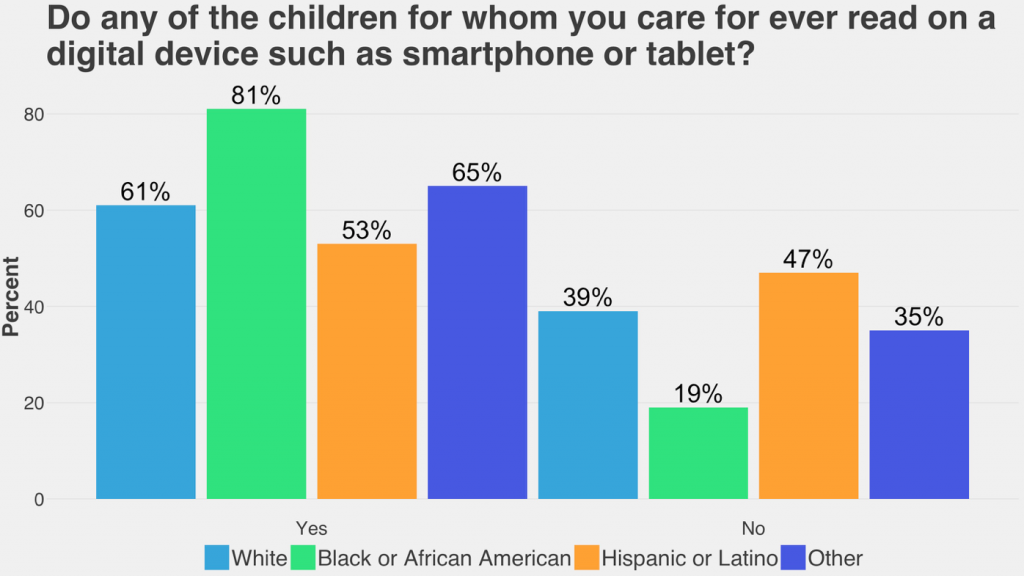BookSpring’s 2019 Central Texas Reading Survey offers insight into the state of reading in Central Texas and early literacy efforts in our community.

This survey provides valuable information about the reading habits of families in Central Texas, while raising many interesting questions about the state of reading in the region, an understanding of the situation families face when it comes to developing readers in their own homes, and how to help those families cultivate reading habits that lead to future academic success.
Signs of Progress for Family Book Ownership
The 2019 Central Texas Reading Survey finds that 31% of caregivers with incomes less that $40,000 in Central Texas have fewer than 20 books at home, which is down slightly from findings of the 2018 survey (35%). The survey found a similar decrease in the overall number of households reporting having fewer than 20 children’s books in the home, from 58% in 2018 to 46% in 2019. While it will take at least one more year of data to know whether a trend is emerging, ownership of children’s books appears to be increasing among Central Texas caregivers with annual incomes below $80,000.
While the number of caregivers with annual incomes in excess of $80,000 with more than 20 books in their home remained constant over the two surveys (67% in 2019, 63% in 2018 – within the margin of error), the share of caregivers with 20 or more books in the home making less than $40,000 annually increased from 32% in 2018 to 40% in 2019.
Likewise, for caregivers making between $40,000 and $80,000, the share increased from 40% in 2018 to 54% in 2019. And while income alone does not determine overall book ownership, it does have an impact: 32% of caregivers with an annual income of less than $40,000 reported having 50 or more total books in their home, while 68% of those reporting income of more than $80,000 reported having more than 50 books in their homes.
Similarly, dramatic differences in book ownership were evident among different racial and ethnic groups: 70% of white caregivers reported having 50 or more books, compared to 36% of African American caregivers and 40% of Hispanic caregivers. Moreover, different groups show different practices in the use of digital reading with their children.
Digital vs Print
Digital devices could be affecting in-home reading habits with nearly half of parents observing that their children spend more time playing on their phone or tablet than reading. Forty-nine percent of children play on the phone/tablet more often than reading Yet despite the prevalence of digital devices among children, print remains the most dominant source for reading by parents: 42% of those surveyed said that print was the format they most frequently used to read, while 39% said that they read most frequently on a phone.
Reading Culture
Parents and caregivers overwhelmingly recognize the importance and enjoyment that comes from reading to and with their children, but 45% still read with their child less than once per day. Yet many still read frequently to their children, 34% once a day, and 21% twice or more a day. The survey also reports that over 90% of Central Texas parents and caregivers believe their children enjoy reading or being read to “some” or “a lot.” And overall, the survey results show an overwhelming support of reading, with most parents and caregivers associating reading as “extremely important” to their children’s academic success –96%. More than half of respondents do not read to or with their child daily, and 71% reported feeling bad for not reading with their child every day.
Download Full Survey Results (pdf)
Methodology
Strategic Research Associates LLC are Jim Henson, PhD and Joshua Blank, PhD. They surveyed 600 residents living in Bastrop, Burnett, Caldwell, Hays, Travis, and Williamson Counties from a representative online panel who indicated that they are the parent or frequent caregiver of a child currently under the age of 12 from August 28 through September 10, 2019. Results were presented with responses weighted by race to better match the target population according to U.S. Census Bureau, 2011-2015 American Community Survey 5-Year estimates of the presence of children under 18 years of age in households in the aforementioned counties. The margin of error for the full sample is +/- 4.00 percentage points.


